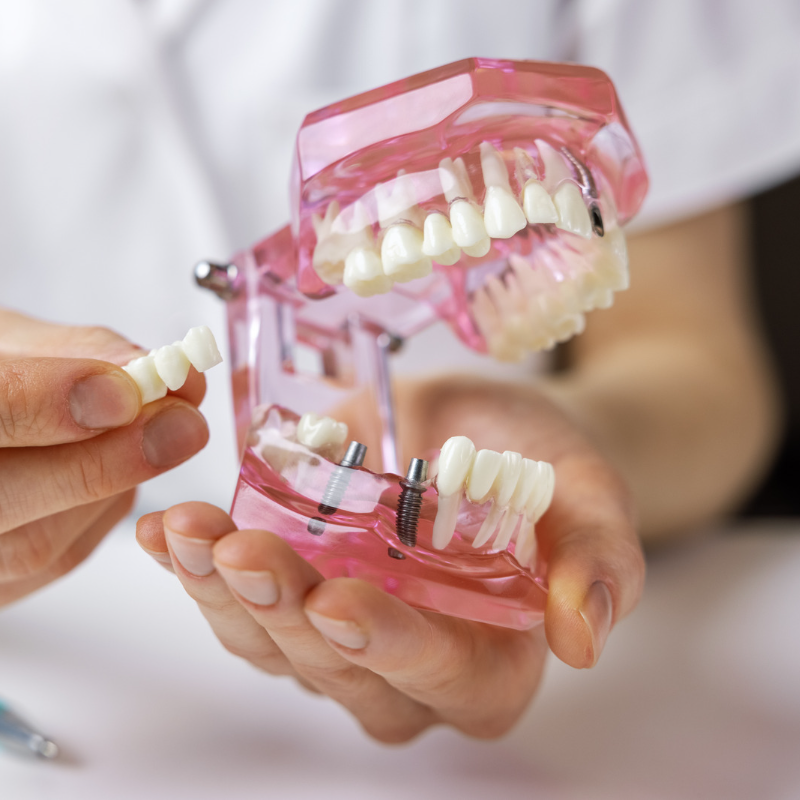How to care for the dental bridge you got in Colombia
Taking care of your new dental bridge is not difficult but there are a few important details to keep in mind.
Practice good general oral hygiene
First and foremost, the best thing you can do is maintain proper oral hygiene. This will extend the life of your dental bridge. While your dental bridge is not susceptible to decay, your underlying support roots and gums are. Bad dental habits increase the risk of developing cavities and/or tartar, putting the integrity of your dental bridge at risk. Proper oral hygiene also prevents gum disease.
Clean underneath the bridge
When you floss natural teeth, your floss slides between your teeth. Because a bridge is a continuous unit, floss will not fit between these none existent spaces. However, food particles, debris, and disease-causing bacteria can get trapped underneath the bridge. These must be removed for optimal oral health. Here are a few tools you can use.
Floss threaders: This tool resembles the eye of a needle. Soft and flexible, this device allows you to “thread” the floss underneath your bridge so you can clean underneath it.
Interproximal brushes: Often described as “Christmas tree brushes”, these tools help clean underneath bridges without the use of dental floss. Simply slide the brush underneath the bridge and clean all surfaces thoroughly.
Dental picks: These are similar to plastic toothpicks with rubberized tips and work like interproximal brushes.
Waterpiks: Waterpiks remove large food particles and other debris that become trapped under the bridge. Please know that waterpiks should never be used in place of flossing.
Use an antibacterial mouthwash
Use an antibacterial mouthwash to clean bacteria away and protect your teeth and bridges from decay.
Avoid hard foods
You can still enjoy all your favorite foods and beverages with a dental bridge. Bridges are strong enough to withstand normal chewing forces. However, it’s possible to chip them on hard foods. Avoid popcorn kernels, hard candy, hard breads, and ice.
Avoid biting hard items
Biting on inedible items such as pens can wear down your dental bridge and cause damage over time.
Avoid teeth-staining drinks and tobacco products
Drinks like red wine, coffee, tea, and soda increase the chances of staining your dental bridge and underlying teeth. Cigarettes and tobacco products will stain your dental bridge as well.
Use non-abrasive toothpaste
Some toothpastes contain ingredients that are too abrasive for your dental bridge, like hydrogen peroxide, sodium bicarbonate, or baking soda. The former will eat away at your dental bridge’ surface while the latter’s gritty texture will cause the dental bridge to lose its color and sheen.
In general, choose gel products over those in paste form as they tend to contain none of the ingredients mentioned. Toothpaste with fluoride will prevent tooth decay as well.
No need to use teeth whitening toothpastes either. They are not necessary and may even be detrimental to your dental bridge.
Use a soft toothbrush
Select a toothbrush with soft bristles. Hard toothbrushes scratch the surface of your dental bridge.
Do not grind your teeth
If you grind your teeth in your sleep, we can create a custom made mouthguard. Excessive grinding can cause your dental bridge to crack, chip, and break down.
If you develop a grinding habit after the dental bridge has been placed, visit a local dentist about getting a mouthguard.
Uneven bite
In most cases, your bite will be normal after a dental dental bridge procedure. However, it can sometimes be difficult to sense your bite when your mouth is numb. If you realize your bite is uneven once your anesthesia wears off, please get in contact with us. We’ll fix the bite to keep the dental bridge from cracking as a result of a "high" bite.
Discomfort or sensitivity
Your newly bridged tooth may be sensitive as the anesthesia wears off. If the bridged tooth still has a nerve, you may experience heat and cold sensitivity. If so, brush with toothpaste designed for sensitive teeth. Intense pain or sensitivity when you bite down can indicate the dental bridge sits too high on the tooth. If this is the case, please contact us.
Loose dental bridge
Sometimes the cement washes out from under the dental bridge. Not only does this allow the dental bridge to become loose, it allows bacteria to leak in and cause decay to the tooth that remains. If a dental bridge feels loose, please let us know.
Dental bridge falls off
Sometimes a dental bridge can fall off as a result of underlying tooth decay and loosening of the cementing material used to place the dental bridge. If your dental bridge comes off, clean it and the front of your tooth. You can replace the dental bridge temporarily using dental adhesive or temporary tooth cement, sold in stores for this purpose. We might be able to re-cement the dental bridge in place. If not, a new dental bridge will need to be made.
Visit your local dentist regularly
It’s important to visit your local dentist every 6 months. They remove tartar and review your oral health, avoiding decay and cavities, which will damage your dental bridge.
